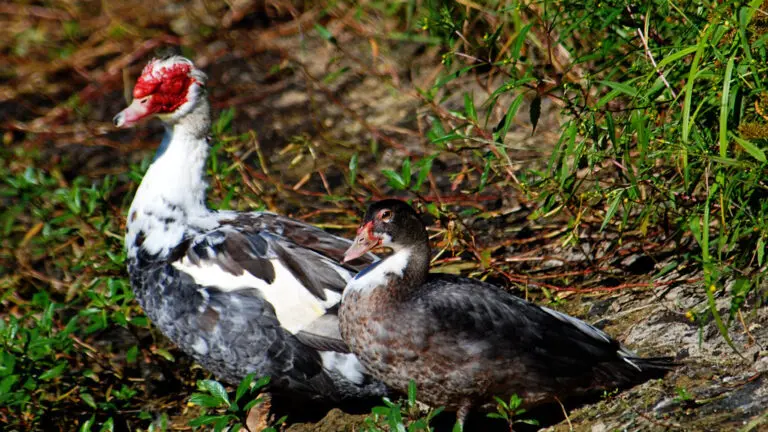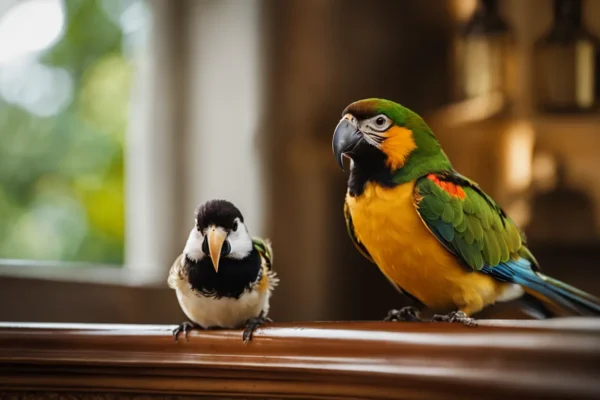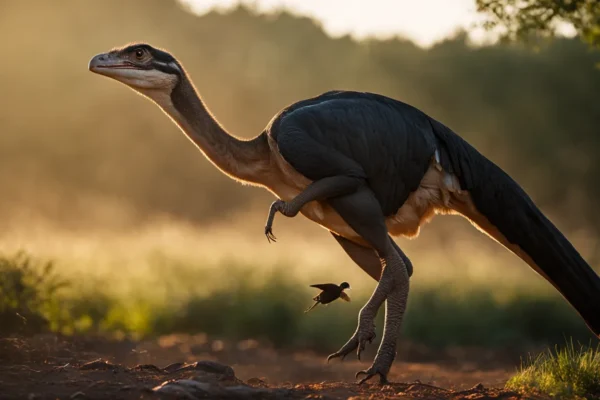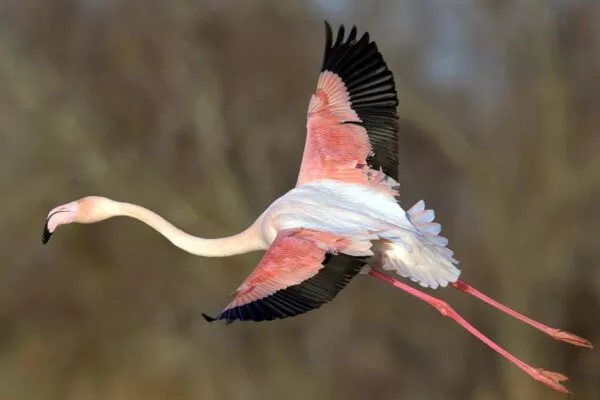Meet the Muscovy ducks, some of the biggest ducks around, hailing from Mexico and parts of South America. These tropical birds are usually spotted near shallow water like ponds and streams, and sometimes in wetlands when they’re out in the wild.
Now, here’s a cool thing about Muscovy ducks – they’re like the survival champs. Even though they’re tropical, they can handle pretty cold temperatures if they have cozy coops.
But wait, there’s more! Most Muscovy ducks you see today are the domestic kind, and they’re quite the stars in the poultry world. Why? Well, each duck can give you a bunch of meat, and get this, it has fewer calories than meat from other birds like turkeys. Although, some say it’s not as flavorful.
Ready for some fun Muscovy facts? Let’s dive in and discover what makes them stand out from other duck buddies like mallards or call ducks!
Muscovy Ducks: Interesting Facts, Habitat, Pictures & More
Scientific Name
The Muscovy duck’s scientific identity is encapsulated in its Latin name: cairina moschata. For the domesticated variant, a sub-classification emerges as cairina moschata domestica.
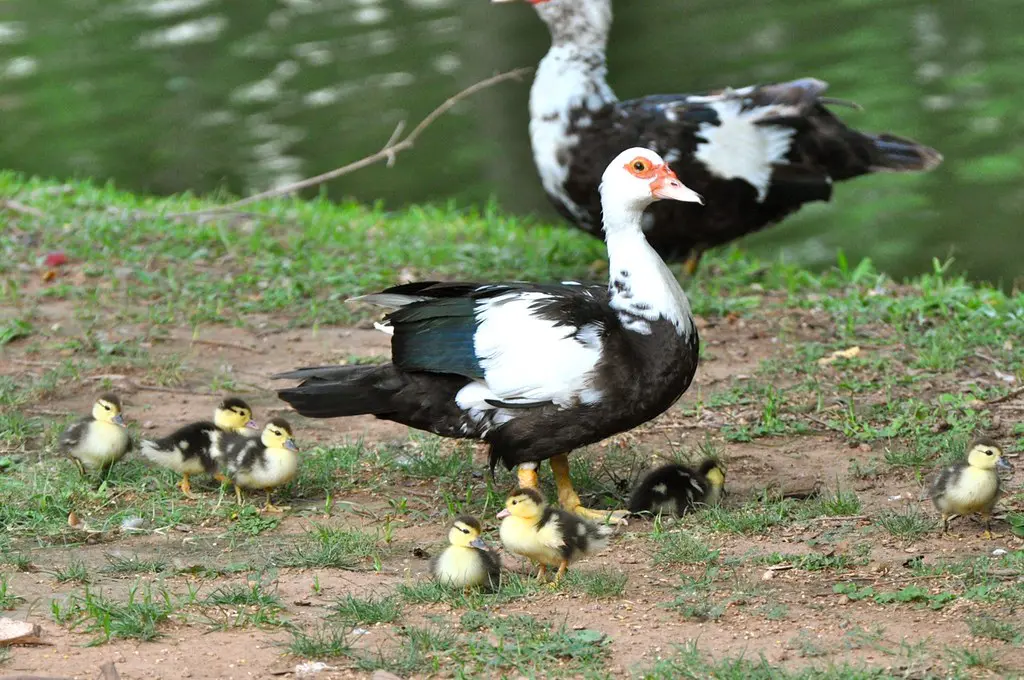
The Diverse Aliases of Muscovy Ducks
Multilingual landscapes offer varied titles for Muscovy ducks. In Spanish, they are referred to as “pato mudo,” translating to “mute duck.” An intriguing linguistic shift occurs in English culinary spheres where the term “Barbary ducks” is commonly employed, showcasing the versatility of nomenclature.
Striking Appearance:
Muscovy ducks are unlike your typical ducks. Their size and build set them apart, with glossy black-and-white feathers and a remarkable red bill. One distinctive feature is their caruncle, lumpy patches of skin that adorn their heads, reminiscent of wattles seen in turkeys and roosters.
Muscovy Duck Size
Curious about the size of Muscovy ducks? The average male measures around 25 to 33 inches (63-83 cm) in length, while the female averages between 20 to 25 inches (50-63 cm). Known for their robust build, Muscovy ducks can tip the scales, with males weighing approximately 10 to 15 pounds (4.5-6.8 kg) and females ranging from 6 to 8 pounds (2.7-3.6 kg). Domesticated breeds can surpass these weights, with the heaviest male Muscovy duck recorded at 18 pounds, making it just a tad lighter than a schnauzer dog.
Duck or Goose?
Muscovy ducks often confound observers, as their behavior differs markedly from typical ducks. They don’t quack, show a preference for trees over lakes, and prompt some to question their duck status. Despite their distinctive habits, Muscovy ducks are scientifically classified as ducks, specifically under the unique classification of cairina moschata, distinguishing them from more common breeds like mallards (anas platyrhynchos).
In the vast family of waterfowl, where mallards might be the familiar faces at your local pond, Muscovy ducks carve out their niche as captivating and distinct members. So, while they may defy some duck norms, Muscovy ducks undeniably belong to the diverse and fascinating world of waterfowl.
The Palette of Red Faces:
Yes, all Muscovy ducks boast reddish faces, showcasing a spectrum from vivid red to muted orange-red. While their faces share this common hue, the rest of their bodies can exhibit variations in color. Wild breeds tend to have darker hues, while domesticated ones come in shades like white, brown, grey, yellow, or lavender, complemented by neon red caruncles.
The Purpose of Red Faces:
The red faces of Muscovy ducks serve a vital purpose. Caruncles, housing essential oil glands, play a crucial role. These ducks possess tiny, oily holes in their caruncles. During grooming sessions, they spread this oil over their feathers, forming a protective layer that aids them when they navigate through water.
Mule Ducks: The Cross-Breed Marvels
Ever heard of “mule ducks”? These intriguing creatures are the result of a unique union between male Muscovy ducks and female Pekin ducks. Drawing parallels with their equine namesakes, mule ducks, like mules, are hybrids that emerge from cross-breeding. While these cross-breeds are infertile, they find valuable roles in farms and zoos, often becoming sought-after sources of income for breeders. Surprisingly, mule ducks play a central role in the production of foie gras, a luxurious dish crafted from the specially fattened liver of ducks destined for slaughter.
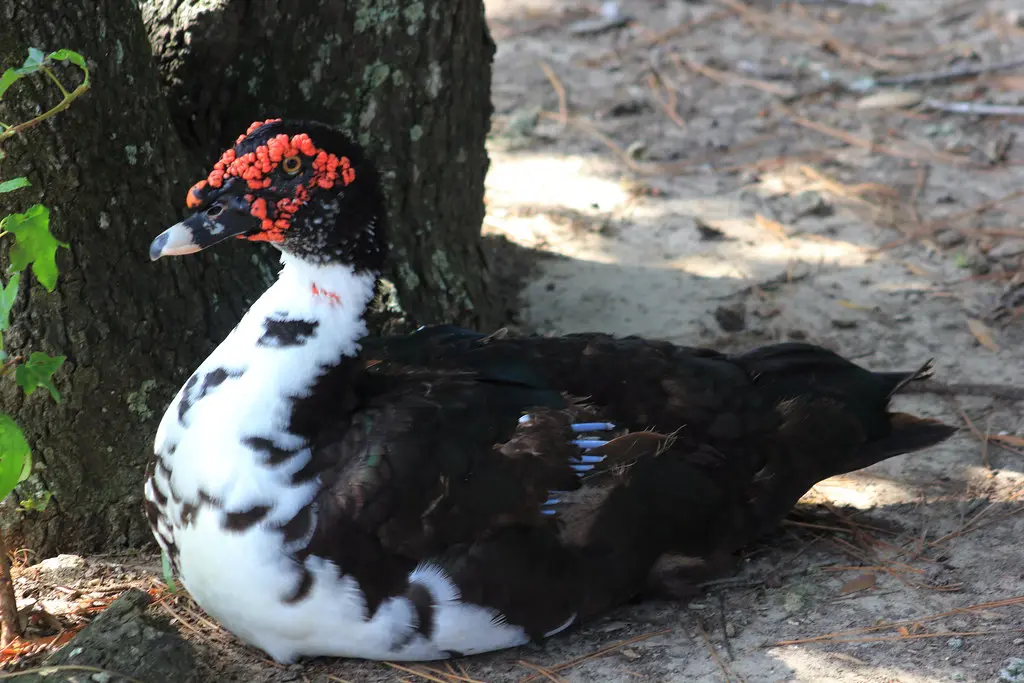
Are Muscovy Ducks Aggressive?
Muscovy ducks carry a notable heft, but are they aggressive? While they may not be inherently hostile, individual temperament can vary. Socialization and environmental factors influence their behavior. Muscovy ducks often become accustomed to humans if raised in proximity, fostering a friendly disposition.
Muscovy Duck’s Weight and Wingspan
Unveiling the impressive weights of Muscovy ducks, males and females tip the scales differently. Males range from 10 to 15 pounds, while females weigh 6 to 8 pounds. However, domesticated Muscovy ducks can exceed these averages. Wingspan, a mark of avian majesty, spans 54 to 60 inches in adult Muscovy ducks, showcasing their impressive size and often leading to confusion with geese.
Muscovy Duck Origins
The etymology of the term “Muscovy duck” remains shrouded in mystery, with several theories attempting to unravel its origins. One plausible explanation suggests a connection to the region near Moscow in Russia, referred to as “Muscovy” in the past. While Muscovy ducks aren’t native to the area, historical exports could have contributed to the nomenclature. Alternatively, the name might evoke a sense of exoticism, a common practice in naming during the Middle Ages, evident in turkeys and guinea pigs named after distant lands. Another theory links the ducks to the Muisca people of ancient Colombia, proposing that variations of “Muisca” transformed into “Muscovy” through trade interactions. Finally, the possibility of the name emerging from the duck’s musky odor adds an olfactory intrigue to their nomenclature.
Muscovy Ducks as pets
Friendship with Muscovy ducks isn’t a universal affair; it hinges on their background. While wild Muscovy ducks tend to maintain a reserved demeanor, their domesticated counterparts are known for their amiable nature. Often raised as livestock or kept as pets, they display friendliness, learning to respond to names and even exhibiting tail-wagging antics reminiscent of canines.
Taming Aggression
Aggression in Muscovy ducks can surface under various circumstances. Boredom, restlessness, territorial instincts, and hunger are common triggers. Timely intervention, especially during their formative years, proves effective in curbing aggressive tendencies. While their antics may seem endearing in their early stages, the potential for harm grows as these ducks mature.
Can Muscovy Ducks Take Flight?
Contrary to expectations, Muscovy ducks are proficient flyers, showcasing their aerial prowess with frequent flights. Roosting on fences, rooftops, sheds, and other elevated spots, they exhibit a preference for heights.
An Absence of Quacks in Muscovy Ducks
In a departure from conventional duck behavior, Muscovy ducks defy the stereotype by eschewing the typical quack. While physically capable of quacking, their vocal repertoire includes loud, quack-like sounds under stress, but this isn’t a common trait.
Hissing Harmony
Muscovy ducks communicate through hissing, a distinctive low sound akin to a snake. This auditory expression serves diverse emotional states, from happiness and excitement to agitation and sadness. Females contribute to the soundscape with cooing or trilling, often reserved for interactions with their offspring, exuding a soothing and contented aura.
The Serene Soundscape of Muscovy Ducks
Muscovy ducks maintain a generally subdued auditory profile. Mistaken for whispers, their hissing and cooing create an unobtrusive soundscape. Even in group settings, their vocalizations remain subtle, akin to the murmur of a gathering rather than an overt display of individual noise.
Decoding Muscovy Duck Behavior
The sight of a Muscovy duck wagging its tail may perplex onlookers, but this behavior carries nuanced meanings. Context serves as the key to interpretation:
- Social Interaction: Tail wagging accompanied by cheerful noises suggests a sociable mood, especially when they bob around human feet.
- Mating Signals: During mating season or when other Muscovy ducks are nearby, tail wagging can be a tactic to attract potential mates.
- Intimidation Display: In the face of perceived threats, tail wagging may coincide with aggressive posturing, amplifying the duck’s size and projecting an intimidating presence.
The Multifaceted Utility of Muscovy Ducks
Beyond their peculiarities, Muscovy ducks offer practical benefits:
- Insect Control: Muscovy ducks prove effective in managing insect populations, including flies, ticks, and mosquitoes, making them valuable for pest control.
- Meat and Eggs: Muscovy ducks are dual-purpose, providing succulent meat and large, flavorful eggs. Renowned for their taste, they are favored in culinary settings.
- Hybrid Breeding: Muscovy ducks can be bred with other species, yielding hybrids used, albeit often infertile, in the production of foie gras.
- Compatibility: With their quiet demeanor, Muscovy ducks make compatible companions for various livestock or wildlife, contributing to a harmonious farm environment.
Life Expectancy of Muscovy Ducks
While definitive research on Muscovy duck lifespans is limited, anecdotal evidence suggests a range of 5 to 15 years. Factors influencing longevity encompass health, environment, breed, diet, reproductive cycles, and human decisions regarding their fate.
Muscovy Ducks as World Travelers
Originating in South and Central America, Muscovy ducks have transcended their native habitats, populating farms and zoos worldwide. Beyond captivity, wild populations have emerged in diverse locations, including Mexico, Canada, France, and the United States.
Unconventional Habits of Muscovy Ducks
Muscovy ducks, distinctively, showcase arboreal tendencies. In addition to aquatic habitats like ponds, rivers, lakes, marshes, and swamps, they exhibit comfort in tree-dwelling. Flying with ease and possessing sturdy claws for gripping, Muscovy ducks perch on branches, even constructing nests in trees.
Muscovy Ducks’ Varied Diet
Muscovy ducks embrace a diverse diet, showcasing their culinary omnivorous preferences. In addition to consuming weeds, grasses, and grains, they exhibit an appetite for insects, reptiles, crustaceans, and amphibians. Renowned for insect control, studies have highlighted their significant impact on reducing fly and maggot populations.
Muscovy Ducks and Pest Control
Muscovy ducks emerge as potent allies in pest control, particularly against ticks. Their menu extends to flies, crickets, caterpillars, grasshoppers, maggots, and various insects at different life stages. With a meticulous approach to foraging, they contribute to reducing insect populations and maintaining ecological balance.
The Culinary Appeal of Muscovy Ducks
Muscovy ducks are celebrated for their delectable, tender meat, often likened to beef more than traditional poultry. This exquisite meat is prominently featured in upscale dining establishments, commonly marketed as “Barbary duck.” Notably, Barbary duck meat boasts lower fat content, positioning it as a kosher option in certain regions, and is frequently promoted as a healthier alternative to fatty dishes.
Distinguishing Muscovy Duck Genders
The most straightforward method to differentiate between male and female Muscovy ducks lies in their size. Males typically exhibit double the size of females, accompanied by more vibrant coloration.
The Gender Lexicon: Drakes, Hens, and Muscovy Ducks
In the avian taxonomy of Muscovy ducks, males are designated as drakes, while females bear the title of hens.
Collective Terminology for Muscovy Ducks
When congregated, a gathering of Muscovy ducks can be referred to as flocks, teams, rafts, or paddlings.
Mating Realities
Contrary to monogamous stereotypes associated with ducks, Muscovy ducks do not form enduring pair bonds. While they may temporarily reunite with previous mates, their mating patterns involve seeking different partners in each mating season.
The Reproductive Cycle of Muscovy Ducks
The mating season for Muscovy ducks spans from August to May. During this period, males employ tail wagging and crest puffing to attract females. Once impregnated, females create nests in tree hollows, laying 8 to 15 sizable eggs. The incubation period extends from 30 to 35 days, with dedicated mothers vigilantly guarding their nests, taking brief breaks only for water and hygiene.
Muscovy Duck Eggs
Female Muscovy ducks produce clutches containing 8 to 15 eggs, distinguished by their considerable size, a notable factor contributing to their desirability. These eggs, weighing twice as much as chicken eggs, constitute prized delicacies.
Muscovy Ducks Uninvited Guests and Invasive Concerns
Muscovy ducks, while beneficial to knowledgeable farmers, can pose significant challenges for others, earning them the designation of an invasive species. Their presence may become problematic due to widespread droppings, damage caused by sharp claws tearing up lawns, and nesting in various residential spaces like patios and balconies. Additionally, Muscovy ducks contribute to ecosystem disruption by eliminating insect populations.
In several regions, including parts of Mexico, Canada, and the United States, Muscovy ducks are officially recognized as invasive. Regulatory measures have been implemented, particularly in states like Florida, where restrictions exist on raising Muscovy ducks for hunting due to concerns about their potential escape and the establishment of uncontrollable wild populations.
Managing Muscovy Ducks
For individuals seeking ways to discourage Muscovy ducks from their properties, several humane methods are available:
- Property Eviction: Engage wildlife services to professionally and compassionately remove Muscovy ducks from your property, avoiding harm or distress to the birds.
- Egg Sterilization: While controversial, preventing the viability of duck eggs by shaking them can be an option. This disrupts the breeding cycle, although it requires patience for the mother duck to realize the change.
- Unappealing Environment: Modify your property to make it less attractive to Muscovy ducks. This can involve covering water sources, installing lights, alarms, or noise-makers, and even introducing a guard dog to deter their presence.
- Trapping: For a limited number of stray ducks, luring them into a covered enclosure for subsequent professional handling is an option. This ensures responsible relocation and prevents the unintentional establishment of new populations.
By adopting non-lethal approaches, individuals can address Muscovy duck-related issues without resorting to harm. The coexistence of humans and these quirky birds can be achieved through thoughtful and humane management strategies.

